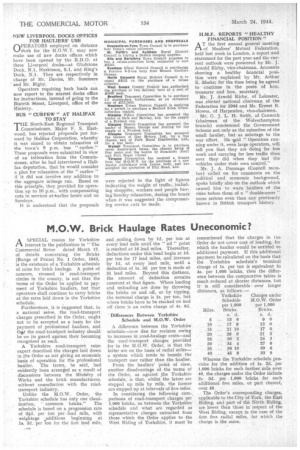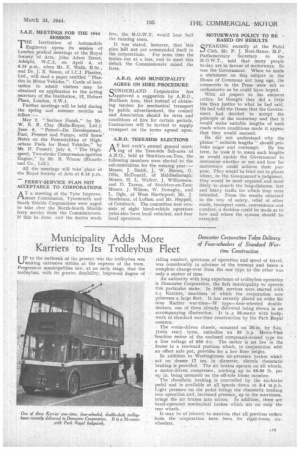M.O.W. Brick Haulage Rates Uneconomic?
Page 20

Page 21

If you've noticed an error in this article please click here to report it so we can fix it.
ASPECIAL reason for Yorkshire interest in the publication in " The Commercial Motor dated March 17, of details concerning the Bricks (Range of Prices) No. I Order, 1943, is the existence of a Yorkshire schedule of rates for brick haulage. A point of concern, stressed in road-transport circles in the county, is not that the terms of the Order be applied to payment of Yorkshire hauliers, but that operators shall continue to carry bricks at the rates laid down in the Yorkshire schedule.
Furthermore, it is suggested that, in a national sense, the road-transport charges prescribed in the Order, ought not to be accepted as a basis for the payment of professional hauliers, and the the road-trantport industry should be on its guard against their becoming recognized as such.
A Yorkshire road-transport rater, expert described the charges laid down in the Order as not giving an economic basis of operation for the professional haulier. The terms, he said, had evidently been arranged as a result of discussions between the Ministry of Works and the brick manufacturers, without consultation with the roadtransport industry.
Unlike the M.0,W. Order, the Yorkshire schedule has only one classification, "common bricks." The schedule is based on a progression rate of 34c1. per ton per lead mile, with weightage _additions beginning at Is. 3d. per ton for the first lead mile, .se
and scalin& down by Id. per ton at every lead mile until the " nil " point is reached at 16 lead miles. Thereafter, deduction's under this head begin at Id. per ton for 17 lead miles, and increase by Id. at every lead mile, until a deduction of Is. 3d per ton is made at 31 lead miles. Beyond this distknce, the amount of deduction remains constant at that figure. Where loading and unloading are done by throwing the bricks on and off, or by tipping, the terminal charge is Is. per ton, but where bricks have to be stacked on 'and off there is an extra charge of 4s. 6d.
Differences Between Yorkshire Schedule and M.O.W. Order A difference between the Yorkshire schedule—now due for revision owing to increases in road-haulage costs—and the road-transport charges provided for in the M.O.W. Order, is that the latter are on the basis" of radial miles— a system which tends to benefit the transport user rather than the haulier.
From the hauliers' point of view, another disadvantage of the terms of the Order, as against the Yorkshire schedule, is that, whilst the latter are stepped up mile by mile, the former are stepped up at intervals of five miles.
In considering the following cons-, parisons of road-transport charges per 1,000 bricks, as between the Yorkshire schedule and what are regarded as representative charges extracted from those which the Order applies to the West Riding of Yorkshire, it must be remembered that the charges in the Order do not cover cost of loading, for which the haulier would be entitled to additional payment. If this additional payment be calculated on the basis that the Yorkshire schedule's terminal charge of Is. per ton is equivalent to 4s. per 1,000 bricks, then the difference between the comparative tables is much reduced at shorter distances; but it is still considerable over longer distances, as follows :— Whereas the Yorkshire schedule provides for the addition of is. 2d. per 1.000 bricks for each further mile over 40, the charges under the Order include 2s. 3d. per 1,000 bricks for each additional five miles, or part thereof, over 40 The Order's corresponding charges, applicable to the City of York, the East Riding, and part of the North Riding, are lower than those in' respect of the West Riding, except in the case of the first five radial miles, for which the charge is the same.
EnInstitution of Automobile gineers opens its session of London general meetings at the Royal
' Society of Arts, John Adam Street, Adelphi, W.C,2, on April 4, at 6.15 p.m., when Mr. F. Walls, B.Sc., and Dr. J. E. Sisson, of I.C.I. Plastics, Ltd., will read a paper entitled "Plastics in Motor Vehicles." Cards of invitation to admit visitors may be obtained on application to the acting secretary of the Institution, 12, Hobart Place, London, S.W.I.
Further meetings will be held during the spring and summer months as follow:— , May 2, "Surface Finish," by Mr. W. E. R. Clay (Rolls-Royce, Ltd.); June 6, " PetrolIts Development, Past, Present and Future, with Some' Notes on the Potentialities of Highoctane Fuels for Road Vehicles," by Mr. H. Fossett: July 4, "The Highspeed, Two-stroke Compression-ignition Engine," by Mr R. Wisner (Ricardo and Co., Ltd.).
All the meetings will take place at the Royal Society of Arts at 6.15 p.m.
FERRY-SERVICE PLAN NOT ACCEPTABLE TO'. CORPORATIONS
AT a meeting of the Tyne Improvement Commission, Tynemouth and South Shields Corporations were urged to take river the North-South Shields ferry service from the Commissioners. If this be done, and the ferries made
free, the M.O.W.T. would bear half the running costs.
It was stated, however, that this plan had not yet commended itself to the corporations. For somc time the ferries ran at a loss, and to meet this deficit the Commissioners raised the fares.
A.R.O. AND MUNICIPALITY AGREE ON HIRE PROCEDURE QUNDERLAND Corporation has bJapproved a suggestion by A.R.O., Northern Area, that instead of obtaining tenders for mechanical transport by public advertisement, the council and Association should fix rates and conditions of hire for certain periods. Contractors will be invited to supply transport on the terms agreed upon.
A.R.O. TEES-SIDE ELECTIONS
A T last week's annual general meet ing of the Tees-side Sub-area of A.R.O., held at Stockton-on-Tees, the following members were elected to the sub-committee for the ensuing year:— Messrs. J. Smith, J. W. Brown, G. 011is, McDonald, of Middlesbrough; Messrs. H. L. Walker, j, Williamson, and D. Tarren, of Stockton-on-Tees; Messrs. J. Wilson, W. Donaghy, and L. Ogle, of West Hartlepool; Mr. J. Sanderson, of Loftus; and Mr. Heppell, of Cornforth. The committee now consists of eight hired-vehicle operators (who also have local vehicles), and four locar operators.
MOTORWAYS POLICY TO BE • BASED ON RESULTS
SPEAKING recently at the Pedal, Club, Mr. P. J. Noel-Baker, M.P., Parliamentary Secretary to the M.O.W.T., said that many people to-day are in favour of motorways. So was the Government. When he made a statement an this subject in the House of Commons not long ago, the comments in the Press were not so enthusiastic as he could have hoped.
With all ,respect to his eminent critics, he thought they did a little less than justice to what he had said. He had told the House that the Government had decided to accept the principle of the motorway andthat it would make suitable lengths of such -roads where conditions made it appear that they would succeed.
He did not understand why the phrase "suitable lengths" should pro . Vole anger and contempt. By the term, he took it to mean such lengths as would enable the Government to determinewhether or not and how far motorways could achieve their purpose. They would be tried out in places where, in the Government's judgment, they would be most required and most likely to absorb the long-distance, fast and heavy traffic for which they were intended. From the results obtained . in the way of safety, relief of other roads, transport costs, convenience and comfort, a decision could be made as to how and where the system should be extended.




















































